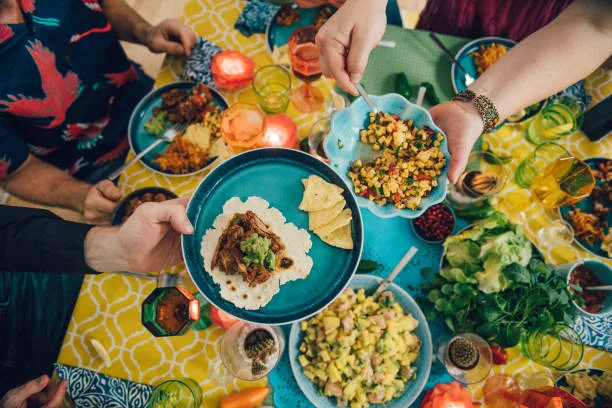Expanding our taste buds with flavors from around the world can be an awesome way to improve health and lose weight. When we explore different cuisines, our taste buds do a happy dance. But it’s about more than just exciting our taste buds – it lets us find tasty new nutrient-packed foods that can help drop pounds and feel amazing.
In this post, we’ll look at how cultural cuisine and healthy eating are connected. You’ll see how traditions and local ingredients impact cooking globally. We’ll uncover the healthiest dishes from different cultures and suggest ways to tweak them for weight loss. By the end, you’ll realize you don’t have to give up flavor or fun to eat right – you just have to expand your culinary horizons!

How Culture Shapes Eating Habits
The foods we crave come from our cultural background and ancestry. Traditions passed down shape what we eat. Mexicans have a thing for corn tortillas, beans, rice and bold salsas. Chinese people drool over dumplings, noodles and mapo tofu.
Our family history defines our tastes early on. We get comfort from the nostalgic flavors of our culture. Holidays and gatherings also keep cultural eating alive – who doesn’t look forward to Grandma’s matzo ball soup or a spicy biryani?
Local ingredients also impact cultural cuisine. Japanese food relies on premium rice, fresh seafood and tangy citrus thanks to the terrain. Costa Rican staples like yucca, beans and tropical fruits come from the lush landscape. Creative recipes develop around what’s readily available.
As we travel, it’s cool to discover each culture’s food identity. And just because we grew up on certain dishes doesn’t mean we can’t make them healthier and waistline-friendly.
Picking Nutritious Dishes from Different Cuisines
The trick is making smart swaps to lighten up heavy traditional dishes. We can tweak cooking methods, swap ingredients and choose lighter options to make cultural cuisine support weight loss.
Let’s explore mouthwatering global flavors and how to make healthy choices:
Savoring Light Asian Fare
Asian food packs nutritious ingredients like lean protein, crisp veggies and antioxidant spices.
Skip fried, fatty meat. Choose grilled, steamed, roasted or stir-fried chicken, seafood, pork or tofu to cut calories. Load up on rainbow vegetables too – bok choy, broccoli, snap peas and more.
At Chinese restaurants, avoid fried apps and heavy sauces. Get broth soups, steamed or pan-fried dumplings and “light” dishes instead. Ask for sauces on the side.
Pass on deep fried tempura when eating Japanese. Enjoy sushi, sashimi and brown rice for fiber. Seaweed salad, edamame and miso soup make light starters.
With Thai, skip coconut-milk curries. Go for fresh basil, ginger and lemongrass dishes piled with veggies.
Marveling at Mediterranean Meals
The Mediterranean diet spotlights healthy fats, fish, whole grains, fruits and vegetables. Olive oil gives you anti-inflammatory benefits, not saturated fat. Herbs and spices replace heavy cream and butter.
For Greek, load up on grilled fish, chicken or shrimp with a fresh veggie-packed salad. Hummus, tzatziki and yogurt dips make healthy starters.
With Italian, choose thin crust pizza piled with veggies and light on cheese. Get whole wheat pasta and pick tomato sauces over creamy ones. Don’t forget salad and roasted veggies on the side.
For Spanish cuisine, start with chilled gazpacho soup or vegetable tapas. Choose grilled fish or light paella with saffron rice and veggies over meaty dishes.
Spicing Up Indian
Indian food can be heavy but it’s delicious. Focus on veggie dishes like aloo gobi or saag paneer. Try lentil dals for protein and fiber too.
Embrace the spices! Flavorful spices have antioxidants and anti-inflammatory power. Just ask for minimal oil and butter.
Pick brown basmati rice or naan bread over fried options. Balance your plate with raita and veggie pakoras. You’ll feel satisfied, not stuffed.
Sensational South American
Beyond heavy tacos and enchiladas, Latin flavors offer healthy, tasty options.
For Mexican, skip the rice, beans and cheese. Get grilled fish, shrimp or chicken fajitas with sautéed peppers and onions. Top tacos and burritos with avocado, pico, lettuce and salsa instead of sour cream.
Brazil’s national dish, feijoada, offers protein-packed beans and lean meat. Pair it with a fresh salad. Snack on tropical fruit instead of sugary drinks.
With Peruvian, try grilled meat or citrus ceviche. Pick lighter rice dishes flavored with veggies and fish. Skip fried apps and embrace chili sauces for flavor without fat.

Mindful Eating Around the World
No matter which amazing cuisine you choose, mindful eating is key. Here are some tips:
- Savor each bite fully. Don’t multitask while eating.
- Use small utensils to slow down and eat with purpose.
- Stop when satisfied, not stuffed.
- Share family-style and box up leftovers right away to control portions.
- Drink water between bites to aid digestion.
- Choose steaming, grilling, baking and roasting over frying, crisping and buttering.
- Make half your plate non-starchy vegetables to fill up on fiber and nutrients.
Mindful eating lets you enjoy all these flavors to the max while prioritizing health. You can savor every bite AND practice portion control.
Respecting Food Traditions
As we explore global cuisine, it’s important to appreciate and respect each region’s food traditions.
Some dishes hold deep meaning in their native cultures. Let’s understand their origins and significance before labeling anything as unhealthy. Certain foods are for celebrations and eaten in moderation.
It’s awesome to try authentic dishes, but do so respectfully. Support local, independent restaurants for true authenticity.
Immersing yourself in new flavors is a joy. Let’s celebrate differences with open minds and bellies! Mindful eating means honoring a dish’s heritage and culture.

An Exciting Food Journey
This global food tour shows how you can enjoy yummy cultural cuisine AND meet health goals through intention and mindfulness.
Here are some key points:
- Cultural foods come from tradition, local ingredients and generational practices. Don’t label dishes as good or bad.
- Make simple swaps to cut fat, sugar and carbs.
- Focus on lean protein and veggie variety. Use herbs, spices, broths and citrus to cut oils without sacrificing taste.
- Practice mindful eating no matter what you choose. Savor slowly, share dishes, stop when satisfied and box up leftovers.
I hope this guide proves eating right doesn’t have to be boring – not when you incorporate global flavors! See every cuisine as a chance to try satisfying, healthy dishes.
Now tell me:
- What’s your favorite healthy ethnic food for weight loss? Share go-to recipes or menu picks!
- What global cuisines do you want to explore through a healthy lens?
- How do you tweak dishes from your cultural background to make them healthier?
Let’s keep sharing tips and inspiration to nourish our bodies while delighting our taste buds on this yummy journey together!
Thank you for reading this post, don't forget to subscribe to our free newsletter
!
